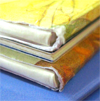|
|
|
|
|
|
|

| 최근 이 책을 구매하신 다른 회원의 책장 |
|
 |
|
|
|
[ 책 소개 ]
* Bank Street - Best Children's Book of the Year Winner
Measuring Penny와 Mapping Penny's World 등 어린 아이들에게 재미와 함께 지식을 주는 Loreen Leedy의 페니시리즈입니다. 이 책에서는 확률의 기초라 할 수 있는 "가능성"의 개념을 쉽고 재미있게 설명해 줍니다.
아울러 이런 가능성을 영어로 표현하는 방법들도 예문 및 그림과 함께 자세히 보여줍니다.
가능성이 높은 것을 표현하는 용어부터 낮은 것을 표현하는 용어 순으로 정리를 하면...
Will - most likely - likely - probably - equal chance - could - might - tiny chance - least likely - can't - impossible
이런 용어들의 차이점과 함께, 어떤 상황에서 어떻게 사용되어야 하는지를 잘 설명해주는 책입니다.
큰 사이즈의 튼튼한 | 닫기x |  What is 하드커버? What is 하드커버?
양장본이라고도 불리우며, 표지가 단단한 판지로 만들어진 책입니다.
판지를 천이나 가죽으로 감싸기도 합니다. 책의 속지는 일반적으로 중성처리된 종이(Acid-free paper)를 사용해서 잘 변질이 되지 않기 때문에 오랫동안 보관하기에 적합합니다. 이 종류의 책은 더스트 재킷, 또는 더스트 커버로 불리는 표지덮개가 함께 있는 경우가 많습니다. 간혹 내부 속지가 콩기름 코팅이 된 경우 고약한 냄새가 나는 책도 있습니다.
|
[ 서지 정보 ]
Hardcover: 32 pages
ISBN-10: 0805073892
ISBN-13: 978-0805073898
책 크기: 28.5 cm x 23.6 cm
[ 영문 서평 ]
Book Description
Lisa’s class is learning about probability. For part of her homework, she has to think of an event that will happen, one that might happen, and one that can’t happen. Who is that Boston terrier that keeps popping into Lisa’s imagination? It’s probably Penny!
Loreen Leedy is widely praised for her ability to make concepts fun and accessible to children, and she has done it again in this great introduction to probability.
School Library Journal
Lisa's class is studying probability. For homework, she must make predictions about what will, might, and can't happen over the weekend. She must also think of different events with varying chances of happening. Penny, her Boston terrier, helps Lisa visualize the situations needed for the assignment. Leedy's uncluttered, computer-generated artwork matches her clear and orderly text. What Lisa imagines - Penny eating a birthday cake, discovering buried treasure, and inventing a jet pack - appears in thought bubbles with scalloped edges. Penny stands out against the textured pastel backgrounds, and her brown eyes are like marbles. Actual photographs, such as of clothes in a laundry basket where the pet discovers a missing toy and of the vegetables they buy at the farmer's market, are used sparingly and heighten the reality of events that do happen. Readers will remember what they have learned about probability because they have seen a charming Boston terrier in both probable and improbable situations. Librarians will most certainly want this follow-up to Measuring Penny (1998) and Mapping Penny's World (2000, both Holt), which are probably in circulation at this very moment.
Booklist
This latest math concept story featuring Penny the Boston terrier tackles a subject more difficult than that presented in Measuring Penny (1998) and Mapping Penny's World (2000). Lisa's teacher assigns the class to study probability by writing down predictions, determining results, and recording them. He demonstrates by using (and eating) jellybeans. Choosing Penny as her focal point, Lisa begins to calculate her results: Will Penny want to go for a walk? (Of course.) What might happen? (Perhaps she'll see a squirrel.) What won't happen? (She won't see a shark.) Using her familiar not-quite-naive style of illustration, Leedy clearly and cleverly depicts the possibilities and choices in panels and segmented pages that feature Penny in funny poses. The amusing jacket, which pictures the perky dog wearing cool sunglasses and a beaded collar, is an enticing beginning. Prediction: this will work well as a learning device. |
|
|
|
|
|
|
|
|
| |
|
|
Sadako
An ALA Notable Boo..
3,200원 | | |
| |
| |
| |
| |
| |
| |
|
|
|
|
|